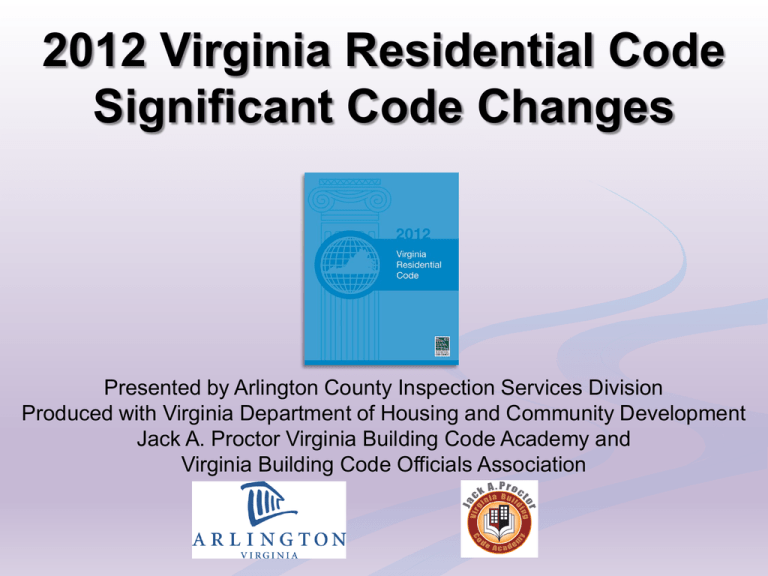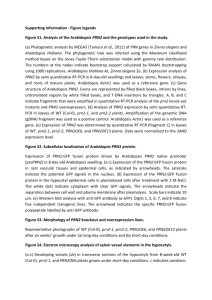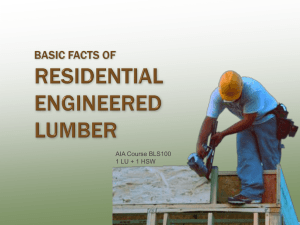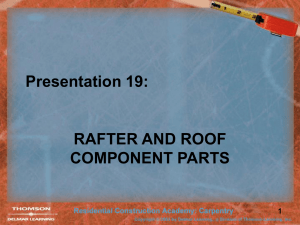2012-Virginia-Residential-Code-Update
advertisement

2012 Virginia Residential Code Significant Code Changes Presented by Arlington County Inspection Services Division Produced with Virginia Department of Housing and Community Development Jack A. Proctor Virginia Building Code Academy and Virginia Building Code Officials Association Welcome! 2 Agenda Significant Technical Changes from 2009 to 2012 Code Editions • • • Includes International Residential Code (IRC) and Virginia Residential Code (VRC) Includes Chapter 2 Definitions through Chapter 10 Chimneys and Fireplaces Highlights Virginia State Amendments Virginia State Amendment 3 Chapter 2 Definitions 4 R202 Definitions Attic, Habitable – finished or unfinished area not considered Story and occupiable area compliant with certain criteria • Floor area per Section R304 • 70 square feet minimum • Ceiling height per Section R305 • 50% required floor area of 7 feet minimum • 0% required floor area below 5 feet • Enclosure with: • Roof assembly above • Floor-ceiling assembly below • Knee walls to sides as applicable 5 R202 Definitions Attic, Habitable definition limited habitable attics in dwellings or townhouses with 3 stories minimum above grade plane to: • 2/3 area maximum of story below or • 400 square feet maximum Hab Attic Attic Attic Hab Attic 2nd 2nd 2nd 2nd 2nd 1st 1st 1st 1st 1st Basement Above Grade Basement Below Grade Basement Above Grade Basement Below Grade 3 Stories / 3 Floors 2 Stories / 4 Floors 3 Stories / 4 Floors 3 Stories / 5 Floors Basement Below Grade 2 Stories / 3 Floors Hab Attic 3rd Example 1 Given: 12” • 3 stories above grade plane • 12/12 pitch hip roof • 3rd floor area = 30’x36’ = 1080 sq ft 12” Hab Attic 3rd Analysis: • 520 sq ft < 2/3x1080 sq ft < 720 sq ft but • 520 sq ft > 400 sq ft 7 36 FT 30 FT 5 FT 5 FT 5 FT 1st Basement Below Grade 5 FT Attic = 20 FT x 26 FT = 520 SQ FT 2nd 3 Stories / 5 Floors Habitable attic not allowed Example 2 Given: • 2 stories above grade plane • 8/12 pitch gable roof • 2nd floor area = 26’x32’ = 832 sq ft 12” 8” Hab Attic 2nd Analysis: • 352 sq ft < 2/3x832 sq ft < 554 sq ft and • 352 sq ft < 400 sq ft 1st Basement Above Grade Attic 11 FT x 32 FT = 352 SQ FT 7.5 FT 8 32 FT 26 FT 7.5 FT 3 Stories / 4 Floors Habitable attic allowed R202 Definitions Basement – any story not defined as Story Above Grade Plane 9 R202 Definitions Story Above Grade Plane – any story with finished floor entirely above Grade Plane or with finished floor directly above: • 6 feet minimum above Grade Plane or • 12 feet minimum above finished ground level at any point Story Above Grade Plane < 6’ >12’ Above Ground Level Grade Plane Basement 10 Understand Grade Plane to determine basements or stories relative to grade plane Grade Plane – reference plane representing average of finished ground levels adjoining building at all exterior walls Lot Line > 6’ Grade Plane 6’ 6’ Lot Line ≤ 6’ Grade Plane 11 Grade Plane where finished ground level slopes away from exterior walls, established reference plane to be at lowest ground point between building and: • Lot line or • 6 feet from building where lot line located beyond 6 feet minimum from building Lot Line > 6’ Grade Plane 6’ 6’ Lot Line ≤ 6’ Grade Plane 12 R202 Definitions Exterior Wall Covering – material or assembly of materials applied to exterior face of exterior wall for purposes of: • Weather resistance • Insulative protection • Aesthetic characteristics Pan Flashing – corrosion-resistant flashing located at opening base and integrated into exterior wall to direct water to exterior 13 R202 Definitions Guestroom – any room or rooms used or intended for use by 1 minimum guest for living or sleeping purposes Lodging House – single family dwelling with 1 minimum primarily permanent occupant who exchanges rent payments for guestroom 14 R202 Definitions Local Exhaust – exhaust system with 1 minimum fan to exhaust air from specific room or rooms in dwellings Whole-House Mechanical Ventilation System – exhaust or supply system designed to mechanically exchange indoor and outdoor air to satisfy ventilation rate and operated continuously or intermittently 15 R202 Definitions Nosing – leading edge of tread on stair and of landing at top of stairway flight and formerly referred to as tread profile Riser – vertical component of step or stair 16 R202 Definitions Photovoltaic Modules / Shingles – roof covering composed of flat-plate photovoltaic modules fabricated into shingles 17 R202 Definitions Vapor Permeable – property of having moisture vapor permeance rating of 5 perms minimum Wind-Borne Debris Region – area within designated hurricane-prone region 18 R202 Definitions Nonpotable Fixtures and Outlets – fixtures and outlets not dependent upon potable water to safely perform intended use Nonpotable Water Systems – water systems for collection, treatment, storage, distribution, and use or reuse of potable water 19 R202 Definitions Gray Water – waste water discharged from: • Lavatories • Bathtubs • Showers • Clothes washers • Laundry trays 20 R202 Definitions Rainwater – natural precipitation from roof surfaces only Stormwater – precipitation discharged across land surface or through conveyances to 1 minimum waterway 21 R202 Definitions Structural Composite Lumber – structural members manufactured with wood elements bonded with exterior adhesives Included definitions of: • Laminated Veneer Lumber (LVL) • Parallel Strand Lumber (PSL) • Laminated Strand Lumber (LSL) • Oriented Strand Lumber (OSL) 22 Chapter 3 Building Planning 23 R301.2.1 Wind Design Criteria Wind speeds correlated with 2010 ASCE 7 24 R302.2.2(2) Parapets Exception: Parapets for townhouses not required where: • Class C minimum roof covering • Non-combustible roof decking or sheathing for 4 feet minimum on both sides of common wall • No roof openings or penetrations within 4 feet minimum of common fire-resistant wall 25 R303.4 Mechanical Ventilation Whole-house mechanical ventilation system required in dwellings where: • Air infiltration rate is less than 5 air changes per hour • Tested with blower door at 0.2 inch pressure • Installed per Section M1507.3 26 R308.4 Hazardous Locations Glazing at hazardous locations: • Section reorganized for ease of reading • Multiple SubSections with titles added • Multiple lists with various criteria and exceptions reduced Stair landings at top of stairs not considered hazardous locations 27 R308.4.6 Glazing Adjacent to Stairs and Ramps Glazing considered hazardous location where adjacent to: • Stairways • Landings between flights of stairs • Ramps and located where: • Bottom of exposed edge 36 inches maximum vertically above plane of adjacent walking surface plane Exception: • Glazing located 36 inches minimum horizontally from walking surface 28 R308.4.6 Glazing Adjacent to Stairs and Ramps 29 R308.4.7 Glazing Adjacent to Bottom Stair Landings Glazing considered hazardous location where adjacent to: • Landings at bottom of stairways and located where: • 36 inches maximum vertically above stair landings • Measured from bottom stair landings not tread nosings • 60 inches maximum horizontally of bottom stair treads • Measured from bottom stair treads not in any direction Exception: • Glazing protected with guards per Section R312 Guards and Window Fall Protection • Located 18 inches minimum from guards 30 R308.4.7 Glazing Adjacent to Bottom Stair Landings 31 R308.6.1 Tubular Daylighting Device Non-operable fenestration unit primarily designed to transmit daylight from roof surface to interior ceiling via tubular conduit 32 R310.2.2 Drainage Window wells to be designed for proper drainage: • By connection to building foundation drainage systems per Section R405.1 Concrete or Masonry Foundations • By approved alternative methods Exception: • Where foundations located on Group I welldrained or sand-gravel soils per Table R405.1 Properties of Classified Soils R311.2.1 Interior Passage Interior passage routes in dwelling units with both living / entertainment area and kitchen on same level as required egress door to provide access to: • Living / Entertainment area • Kitchen and where provided on same level as living / entertainment area and kitchen: • 1 bedroom minimum • 1 bathroom minimum with water closet, lavatory, and bathtub or shower 34 R311.2.1 Interior Passage Interior passage routes to provide access to those required areas with: • Doors of 34 inch minimum nominal width • Cased openings of 34 inch minimum clear width Exceptions: • Doors or cased openings located at end and facing length of interior passage routes / access hallways not of adequate accommodating width • Doors or cased openings serving closets • Doors or cased openings serving pantries • Doors serving bathrooms accessed directly from 35 bedrooms not required to comply Example 1 36 39 Example 2 37 40 Example 3 38 R311.3.1 Floor Elevation at Required Egress Doors Landings or finished floors at required egress doors to be 1½ inch maximum below top of door thresholds Exception: • Landings or finished floors at 8¼ inch maximum below top of door thresholds where: • On exterior side • Not having door swings over landings or floors (door swings to interior side) 39 R311.7.6 Landing for Stairways Landings or floors to be located at top and bottom of each stairway • Depth parallel to travel to be 36 inches minimum • Width perpendicular to travel to be equal to stair width served minimum Exception: • Landings at top of interior stairways without door swing over stairs not required 40 R311.7.6 Landing for Stairways Curve, angle, geometry, or shape other than square or rectangle allowed where: • Depth at walkline equal to minimum of depth at walkline for required rectangular landing • Area at landing equal to minimum of quarter circle with radius equal to required landing width 41 R311.7.6 Landing for Stairways Figure R311.7.6(2) Example of Landings Of Other Shapes 42 R311.7.6 Landing for Stairways Required landing walkline and area to safely turn and navigate stairways 43 Understand Walkline to determine curved, angular, or geometrically shaped stair landings other than squared or rectangular • Measured 12 inches minimum along stair nosing from extreme clear stair width 44 R314.1 Smoke Detection and Notification Physical interconnection of smoke alarms not required where wireless interconnection provided 45 R315.2 Carbon Monoxide Detection Systems Household carbon monoxide (CO) detection system allowed where equipment: • Owned by homeowner • Affixed permanently within occupancy • Monitored by approved supervising station • Installed per NFPA 720 • Listed and labeled per UL 2075 46 R316.4 Thermal Barrier Foam plastics to be separated from interior spaces with approved thermal barriers: • ½ inch minimum gypsum wallboard • Other materials tested and accepted per NFPA 275 47 R316.5.3 Attics Thermal barriers per Section R316.4 Thermal Barriers not required in attics where complying with certain criteria Foam plastic insulation to be protected against ignition with 1 of 7 listed ignition barrier materials: • Included 1½ inch thick cellulose insulation 48 R317.3 Fasteners and Connectors in Contact with Preservative-Treated and Fire-Retardant-Treated Wood Fasteners, connectors, and nuts and washers to be approved for contact with preservative-treated wood, fire retardant treated wood, and wood foundations Referred to Sections R317.3.1 through R317.3.4 49 R317.3.1 Fasteners for PreservativeTreated Wood Accepted fasteners: • Hot-dipped, zinc-coated galvanized steel • Stainless steel • Silicon bronze • Copper Exceptions: • Steel bolts of ½ inch diameter minimum • Other fasteners, not nails or timber rivets, of mechanically-deposited zinc-coated steel • Plain carbon steel fasteners in dry interior environment for SBX / DOT and zinc borate preservative-treated 50 wood R317.3.3 – R317.3.4 Fasteners for Fire-Retardant-Treated Wood Section R317.3.3 Accepted fasteners in exterior or wet / damp locations: • Hot-dipped, zinc-coated galvanized steel • Stainless steel • Silicon bronze • Copper • Other fasteners, not nails or timber rivets, of mechanically-deposited zinc-coated steel R317.3.4 Accepted fasteners in interior locations: • Per manufacturer recommendations • Per Section R317.3.3 above in absence of manufacturer recommendations 51 R317.4.1 Labeling Wood / Plastic composite materials for exterior: • Deck boards • Stair treads • Handrails • Guardrails to be labeled with: • Maximum allowable load • Maximum allowable span • Required performance level • Compliant with ASTM D 7032 52 R325 Swimming Pools International Swimming Pool and Spa Code (ISPSC) for swimming pool requirements referenced References to VRC Appendix G Swimming Pools, Spas, and Hot Tubs deleted 53 Chapter 4 Foundations 54 R405.1 Concrete or Masonry Foundation Drains Perforated drains to be surrounded with: • Approved filter membranes • Filter membranes covering washed gravel or crushed rock that cover drains Exception: • Where foundations located on Group I welldrained or sand-gravel soils per Table R405.1 Properties of Soils Classified 55 R408.3.1 Termite Inspection Unvented crawl spaces to provide clear and unobstructed view of vertical face of sill plate Inspection gap to be provided: • Below sill plate at top of interior foundation wall covering • Throughout all enclosed foundations • 1 inch minimum in width • 2 inches maximum in width Exceptions: • Areas not subject to termite damage per Table R301.2(1) Climatic and Geographic Design Criteria • Areas provided with other approved inspection 56 means R408.3.1 Termite Inspection Pier and curtain foundations to provide clear and unobstructed view of interior face of rim joist and sill plate Exception: • Fiberglass or similar insulation where easily removable 57 Chapter 5 Floors 58 R501.3 Fire Protection of Floors Section R501.3 Fire Protection of Floors deleted in entirety Fire protection of non-fire-resistance rated floor assemblies with membranes applied to underside of 2”x8” or less nominal floor framing members not required Referred to Virginia DHCD errata 59 R502.1.3, R602.1.1, and R802.1.2 End Jointed Lumber End-jointed lumber in required fire-resistance rated assemblies to be designated with Heat Resistant Adhesive or HRA within grade mark Also required in: • Section R602.1.1 Wall Construction / Wood Framing • Section R802.1.2 Roof-Ceiling Construction / Wood Framing 60 R502.3 Allowable Joist Spans Tables R502.3.1(1) and R502.3.1(2) Floor Joist Spans for Common Lumber Species revised to reflect reduced allowable floor joist spans for Southern Pine lumber 61 R502.5 Allowable Girder and Header Spans Tables R502.5(1) Girder and Header Spans for Exterior Bearing Walls and R502.5(2) Girder and Header Spans for Interior Bearing Walls revised to require Southern Pine Number 1 Grade minimum lumber Table R502.5(3) Girder and Header Spans for Porches added • Based on Southern Pine • Based on Number 2 Grade minimum lumber 62 R502.6 Bearing Ends of joists, beams, and girders to bear on: • Masonry or concrete directly • Sill plate • 2 inch minimum nominal thickness • 48 square inches minimum nominal bearing area 63 R503.2.1, R602.3, and R803.2.1 Wood Structural Panel Sheathing Identification and Grade Wood structural panels to comply with DOC PS 1 or DOC PS 2 and to be identified by grade mark or certificate of inspection by approved agency with: • Grade • Bond classification • Performance category Also required in: • Section R602.3 Wall Construction / Wood Framing • Section R803.2.1 Roof-Ceiling Construction / Wood 64 Framing R506.2.3 Vapor Retarder Exception 1: Vapor retarder allowed to be omitted from: • Attached and detached garages • Utility buildings • Other unheated accessory structures 65 R507 Decks Section R507 Decks relocated and revised from Section R502.2.2 Decks Allowable spans for deck joists and deck beams reduced to reflect wet service conditions 66 R507 Decks Multiple Sections, Tables, and Figures added and revised • • • • • • • • • • • Section R507.4 Decking Table R507.4 Maximum Joist Spacing Section R507.5 Deck Joists Table R507.5 Deck Joist Spans and Cantilevers for Common Lumber Species Section R507.6 Deck Beams Table R507.6 Typical Deck Beam Spans Section R507.7 Deck Joist and Deck Beam Bearing Section R507.7.1 Deck Beam to Deck Post Section R507.8 Deck Posts Section R507.8.1 Deck Post to Deck Footing Table R507.8 Deck Post Heights 67 Chapter 6 Wall Construction 68 R602.3 Design and Construction Section R602.3 Design and Construction revised to include: • Components of exterior walls to be fastened per Tables R602.3(1) through R602.3(4) • Wall sheathing to be fastened directly to framing members and capable of resisting applicable adjusted wind pressures per Tables R301.2(2) and R301.2(3) where on exterior side of exterior wall • Wood structural panel sheathing on exterior wall to comply with DOC PS 1 or DOC PS 2 • Wall sheathing for exterior wall covering purposes only to comply with Section R703 Exterior 69 Covering R602.3 Design and Construction Table R602.3(1) Fastener Schedule For Structural Members revised 70 R602.3.1 Stud Size, Height, and Spacing Exception 2 for studs 10 feet minimum in height revised • 2”x6” studs at 16” oc allowed to be 18 feet in height • 2”x6” studs at 12” oc allowed to be 20 feet in height • To be Number 2 Grade minimum lumber • To support 1 maximum roof load • To support tributary roof load of 6 feet maximum and where: • Snow load of 25 psf maximum • Ultimate wind design speed of 130 mph maximum Table R602.3.1 Maximum Allowable Length of Wood Wall Studs deleted 71 R602.7 Single Member Headers Table R602.7.1 Spans for Minimum Number 2 Grade Single Header added Exterior Bearing Wall Alternative Framing Without Cripple Wall 72 R602.7.4 Supports for Headers Headers to be supported on each end with 1 jack stud and 1 king stud minimum King studs to be fastened to each end of headers with 4 -12d nails minimum 73 R602.10 Wall Bracing Wall bracing required per 1 of 3 Sections: • R602.10 Wall Bracing • R602.12 Practical Wall Bracing or • R301.1 Design Criteria, including • Engineered designs • Construction systems • Alternative provisions and approved Referenced Standards • AFPA WFCM Wood Frame Construction Manual • AISI S230 Standard for Cold-Formed Steel Framing – Prescriptive Method • ICC 400 Standard on Design and Construction of Log Structures Building Official permitted to waive analysis of 74 upper floors in certain conditions R602.12 Practical Wall Bracing Allowed where compliant with certain wall braced panel criteria: • Braced wall panel requirements • Sheathing materials • Circumscribed rectangles • Side bracing lengths • Contributing cumulative bracing lengths • Common bracing with skewed rectangles • Cripple walls • Walk-out basement walls • Distribution • Connections • Supports 75 R602.12 Practical Wall Bracing Specific braced wall panel requirements: • Heights • Lengths • Joints • Methods per Sections R602.10.4 and R602.10.6 Construction Methods for Braced Wall Panels • • • • ABW – Alternate braced wall panels PFH – Portal frame with holddowns PFG – Portal frame at garage door openings CS-PF – Continuously sheathed portal frame • Interior finish materials • ½ inch minimum gypsum board fastened per Table R702.3.5 Minimum Thickness and Application of Gypsum Board 76 R602.12.3 Circumscribed Rectangles Required length of wall bracing to be calculated by circumscribing 1 minimum rectangle around building and/or portions thereof • Areas included: • Enclosed offsets • Enclosed projections • Areas excluded: • Chimneys • Partial height offsets and projections • Open areas and structures Each rectangle to be: • 80 feet maximum lengths of sides • 3:1 ratio maximum between long and short sides • Skewed to include angled offsets and projections 77 R602.12 Practical Wall Bracing Upper floor wall braced panel analysis not required where: • Approved per Building Official • Upper floor ceiling height ≤ lower floor ceiling height • Upper floor window area ≤ lower floor window area 78 Chapter 7 Wall Covering 79 R703.7.3.2 Maximum Spans Section R703.7.3.2 Maximum Spans Condition 4 and Table R703.7.3.2 Masonry Veneer Height Above Openings added to provide minimum and maximum masonry veneer heights above lintel openings 80 R703.7.4 Masonry Veneer Anchorage Table R703.7.4 Tie Attachment and Air Space Requirements added for masonry veneer 81 Chapter 8 Roof-Ceiling Construction 82 R802.4 Allowable Ceiling Joist Spans Tables R802.4(1) and R802.4(2) Ceiling Joist Spans For Common Lumber Species revised to reflect reduced allowable spans of Southern Pine lumber 83 R802.5 Allowable Rafter Spans Tables R802.5(1) through R802.5(9) Rafter Spans For Common Lumber Species revised to reflect reduced allowable spans of Southern Pine lumber 84 R802.7.1 Sawn Lumber Section R802.7.1.1 Cantilevered Portions of Rafters relocated Exception from Section R502.8.1 and limited notches: • To cantilever length of 24 inches maximum • Measured at exterior face of supporting member • To retain 3½ inches minimum depth of rafter member at rafter ends / tails • Measured parallel to rafter depth 85 R802.7.1 Sawn Lumber Section R802.7.1.1 Ceiling Joist Taper Cut added and limited taper cuts: • To ¼ depth maximum of ceiling joist member • Measured at interior face of supporting member 86 R802.11.1 Uplift Resistance Roof assemblies, rafters, and trusses to attach to supporting wall assemblies and provide uplift resistance per Table 802.11 Rafter or Truss Uplift Connection Forces from Wind Uplift forces to be determined by: • Table R802.11 Rafter or Truss Uplift Connection Forces from Wind • Accepted engineering practice • Truss design drawings 87 R802.11.1 Uplift Resistance Alternative allowed to comply with Table R602.3(1) Fastener Schedule for Structural Members where: • Uplift force of 200 pound maximum • Rafter or truss spacing of 24 inches oc maximum or where: • Basic wind speed of 90 mph maximum • Wind exposure category of B • Roof pitch 5/12 minimum • Roof span of 32 feel maximum • Rafter or truss spacing of 24 inches oc maximum 88 R806.5 Unvented Attic and Unvented Enclosed Rafter Assemblies Allows unvented enclosed rafter assemblies where ceiling is applied directly to rafters • To be contained within building envelope • Air-impermeable and air-permeable insulation directly under structural roof sheathing to be installed per 1 of 3 conditions • ¼ inch vented air space to separate wood shingles or shakes and roof underlayment above structural sheathing • Class I vapor retarders not to be installed on ceiling side of assembly 89 R806.5 Unvented Attic and Unvented Enclosed Rafter Assemblies Condition 5.4 added to allow preformed insulation board as air-impermeable insulation layer • Sealed at perimeter edges on ceiling side of each board to form continuous layer 90 Chapter 9 Roof Assemblies 91 R903.2.1 Locations Flashing to divert water from intersections of sloped roof eaves and vertical sidewalls 92 R905.2.8.3 Sidewall Flashing Base flashing against vertical sidewall to direct water to roof or gutter and to be: • Continuous or step method • 4 inches in width • 4 inches in height and installed per: • Section R703.6.3 Water-Resistive Barriers under exterior plaster or adhered masonry veneer • Section R703.7.2.2 Support by Roof Construction under anchored masonry veneer • Continuous method under siding Section R905.2.8.5 Drip Edge deleted 93 Chapter 10 Chimneys and Fireplaces 94 R1001.8 Smoke Chamber Interior surfaces of masonry fireplace smoke chambers formed with corbelled masonry to be parged smooth 86 95 R1003.9 Termination Section R1003.9.1 Chimney Caps on masonry chimneys to be provided of sloped concrete, metal, or stone with drip edges and caulked bond breaks around flue liners per ASTM C 1283 • Mandatory and required Section R1003.9.3 Rain Caps of masonry or metal installed on masonry chimneys to allow net free area under caps of 4x net free area of chimney flue outlets served • Not mandatory or required 96 Questions or Comments? Thank you 97 Thanks and Credits to: Jack A. Proctor Virginia Building Code Academy Virginia Building Code Officials Association Roger Robertson, JAPVBCA Instructor Paula Eubank, Arlington County Chuck Vernon, Arlington County Chuck Bajnai, Chesterfield County Richard Moore, Henrico County Art Berkley, Isle of Wight Caleb Sulzen, Louisa County










